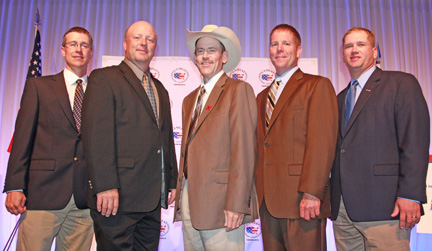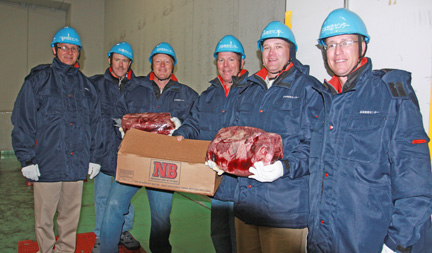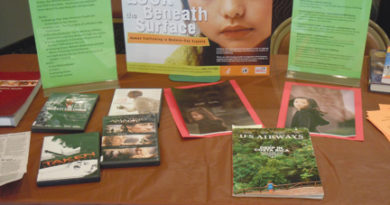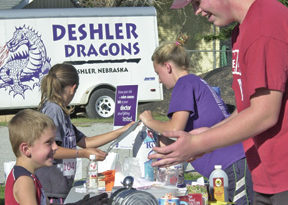Jagels participates in Japanese beef trade mission
A group of Nebraska corn farmers and cattlemen have returned from a trade mission in Japan convinced that Japan will soon return to its traditional spot as the number one export customer for U.S. beef.
The Nebraska Corn Board funded the participation of five Nebraska producers on the Japan mission, which centered on Tokyo and the Sendai region. Tim Scheer of St. Paul and Mark Jagels of Davenport represented the Nebraska Corn Board. Kyle Cantrell of Anselmo represented the Nebraska Corn Growers, while Dale Spencer of Brewster and Doug Parde of Sterling participated on behalf of Nebraska Cattlemen.
Jagels is the chair-elect of the U.S. Meat Export Federation (USMEF), a Denver-based organization supported in part with checkoff funds from the Nebraska Corn Board and dozens of other U.S. organizations. USMEF is responsible for market development and promotion of U.S. beef, pork and lamb around the world. The trade mission was hosted by USMEF’s staff in Tokyo.
In January 2013, Japan agreed to permit imports of U.S. beef from animals aged 30 months and younger, up from an earlier restriction of 20 months and younger that was adopted after a 2003 mad-cow disease scare involving one case of the disease, bovine spongiform encephalopathy (BSE), in Washington involving a Canadian-born cow. Now that the restriction has been raised to the 30-month level, about 95 percent of U.S. beef now qualifies for import into Japan.
For all practical purposes, American beef has been out of the Japanese market in the ten years since the BSE scare. “During that time, Australia and New Zealand have been very aggressive in promoting their product into Japan with considerable success,” Jagels said. “We need to reintroduce Japanese consumers to the robust flavor of American corn-fed beef—and teach them ways to prepare and enjoy convenient and delicious dishes featuring U.S. beef.”
Already, sales of U.S. beef into Japan are on track to exceed $1 billion in value this year, up from virtually zero in 2006. The Japanese market is particularly important to U.S. beef producers since Japan is a high-volume purchaser of beef cuts that are not highly valued in the U.S. “Beef tongue, short plate, skirt and variety meats are greatly desired by Japanese consumers,” Scheer said. “Beef tongue that brings about $1.50 per pound in the U.S. will command $7 per pound in Japan—and that adds value to every beef animal raised in America.”
The Nebraska team was able to take part in two significant promotions sponsored by USMEF. Some 40 influential “foodie” bloggers from across the country were invited to a luncheon featuring Rika Yukimasa, a rising television star and mother of two.
She prepared a number of dishes featuring U.S. beef and pork—and the bloggers reacted with enthusiasm, rushing the stage several times to snap pictures of the food. “Many of these bloggers have 20,000 readers everyday,” Scheer said. “With that one event, USMEF was able to create a firestorm of positive news about U.S. beef and pork on the Internet in Japan.”
The following day, 640 high-level meat buyers and purveyors were on hand for a beef and pork training and information seminar, during which USMEF staffers outlined the consumer promotion campaigns, provided educational information on U.S. beef and pork, and answered questions. Following the seminar, the participants were treated to a buffet dinner featuring a wide range of dishes featuring U.S. beef and pork.
“Within a 36-hour period, USMEF reached some of the most important decision-makers and influencers in Japan,” Jagels said. “Add to that the aggressive consumer advertising and public relations campaigns that are underway, and it’s very clear that our checkoff dollars are being used to great effect in getting U.S. beef back on Japanese dinner plates.”
During the weeklong trade mission, the Nebraska team also:
• Met with several of the top Japanese importers of U.S. beef to discuss their outlook for increased business and their expectations in terms of quality, service and delivery;
• Visited retail establishments to see how U.S. beef and competitive products are being displayed, marketed, packaged and promoted;
• Met with key restaurant chains that feature U.S. beef on their menus, including one chain that specializes in beef tongue (with 30+ different tongue items on the menu!);
• Saw a major advertising campaign for U.S. beef in Tokyo station, one of the largest metro transit stations in that city of 30 million people;
• Toured the Yokohama port facility, through which a large volume of U.S. beef enters Japan;
• Visited a food processing facility that transforms U.S. beef into ready-to-eat convenience meals;
• Visited Japan’s largest cold storage facility, which featured a large inventory of American beef and pork—as well as products from a number of competitor nations;
• Got a first-hand look at a Wagyu beef feeding facility as well as an auction of Wagyu beef carcasses. Wagyu beef is highly marbled Japanese beef. It’s also highly valued. One 950-lb carcass on auction brought $12,000 US.
“The USMEF Japan team has done an excellent job in raising the profile of American beef and creating excitement that U.S. beef is back in Japan,” Scheer said. “All of the key contacts we met were very complimentary of the efforts of USMEF staff and were extremely optimistic about their increased use of American beef.”
The group also visited Katsura Island off the coast of Sendai, Japan, the area devastated by the March 2011 earthquake and tsunami. The Nebraska Corn Board was the first commodity organization within USMEF membership to be in Japan with support for the islanders and other victims. Working with USMEF, the Nebraska Corn Board and Nebraska Beef Council helped provide beef and pork and other foodstuffs to the remaining islanders. USMEF partnered with a number of Japanese organizations to make that happen and continues to do so.
One of those organizations is Bond and Justice, a group of Japanese thirty-somethings involved in the nation’s hip-hop music industry. During the team’s visit, the Bond and Justice group grilled U.S. beef and served the Nebraska team as well as dozens of island residents. The musicians have been visiting Katsura Island about twice a month since the disaster to provide food and social connections for the islanders. USMEF continues to provide beef and pork for these visits.
“Our relief efforts are greatly appreciated as the people of the Sendai region struggle to rebuild their communities and their lives,” Scheer said. “We should be thankful that Nebraska is in a position to provide food and support for our Japanese friends who have suffered through unspeakable disaster.”
The group returned to Nebraska optimistic about the prospects for regaining market share for U.S. beef in Japan. “It’s clear that Japanese importers are very excited and relieved to have American beef back in the marketplace,” Jagels said. “Once Japanese consumers again experience the flavor, tenderness and unique qualities of American beef, we expect beef exports to Japan to go nowhere but up. Since Nebraska is a national leader in beef production, this will have a tremendous positive effect on our state’s livestock industry.”
For a detailed blog on the mission, visit www.midwestcorngrowers.blogspot.com.




